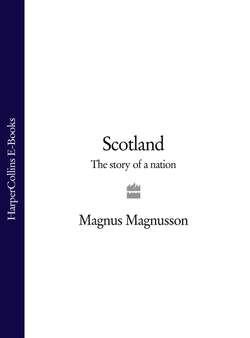Читать книгу Scotland: The Story of a Nation - Magnus Magnusson - Страница 18
The ‘Picts’
ОглавлениеSo who were these people, these Picts? The first thing to recognise is that there was nothing ‘mysterious’ or ‘problematic’ about them, as scholars used to state. The Picts were not a new element in the population: ‘Picts’ (‘picti’ – painted ones) was simply the Roman nickname for the tribal descendants of the indigenous Iron Age tribes of northern Scotland.1 Anna Ritchie, in Picts (Historic Scotland, 1989), puts it like this:
The Picts were Celts. Their ultimate ancestors were the people who built the great stone circles like Calanais on the Isle of Lewis in the third millennium BC in Neolithic times, and the brochs in the early Iron Age from about 600 BC to AD 200. We have no evidence of any major invasions of Scotland after the initial colonisation by farming peoples soon after 4000 BC – there seems to have been very little fresh blood coming in during the Bronze Age.
Just outside the town of Brechin, in Angus, by the A90 trunk road from Dundee to Aberdeen, an impressive £1.2 million visitor centre was opened in the summer of 1999 in the country park of the Brechin Castle Centre. It is called Pictavia, and can be described as somewhere between a museum and a theme park. The display tells, vividly and graphically, the story of the Picts, and is a splendid introduction to their world for visitors of all ages and abilities; it includes not only many examples of Pictish stones and jewellery but also interactive computer facilities explaining the meanings of Pictish symbols (‘Cyber Symbols’) and the sounds of Pictish music (the ‘Tower of Sound’).
Some time after the age of King Bridei, of Craig Phadrig fame, the centre of Pictish power moved southward, to Angus, Perthshire and Fife, but the Picts’ distinctive culture did not change. They were not by any means the painted barbarians described by Roman chroniclers; on the contrary, they were a cultured society ruled by a sophisticated warrior aristocracy which could afford to employ learned men and, more particularly, craftsmen of all kinds – particularly the sculptors who fashioned the magnificent carved stones which are the unique legacy of the Picts.
This period of early Scottish history has long been known as the ‘Dark Ages’, not because the deeds of the time were so dark but because the documentary sources are too meagre to shed a great deal of light. Modern historians prefer to call the ‘Dark Age’ of Scotland by a less misleading name – ‘Early Medieval’. What is clear is that it was a time of considerable and rapid political and ethnic change. By pulling together the sometimes elusive accounts of medieval chroniclers, and calling in all the available archaeological evidence, it is now possible to see various historical patterns developing in Scotland, both north and south of the Forth – Clyde line.
In our attempt to understand the changing shape of early Scotland it would be enormously useful to be able to call upon the aid of television, with its graphic use of ‘morphing’ – merging collages of images into one another, like long-range weather forecasts. The pattern of conquests and occupations in Scotland in the centuries succeeding the Roman withdrawal presents a confusing kaleidoscope of shifts in power, like an ever-changing jigsaw puzzle. Before we reach a more stable picture of ‘Scotland’ in the twelfth century, say (the time of David I – see Chapter 6), we have to follow the fortunes of several apparently different groupings: Picts, Gododdin, Angles, Britons/Celts and Scoti/Scots/Gaels, as well as specific kingdoms like Pictland, Fortriu, Strathclyde, Rheged, Alba and ultimately Scotia.
